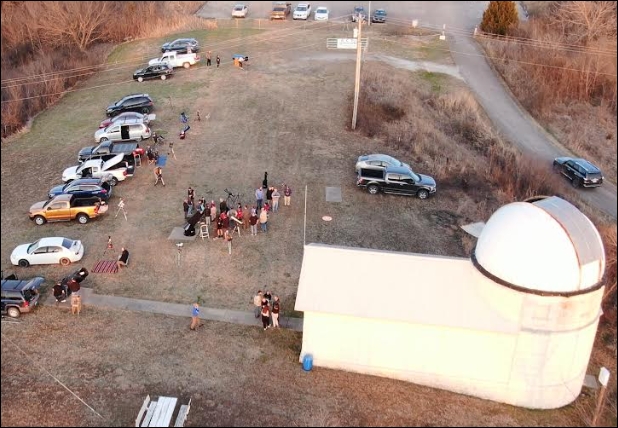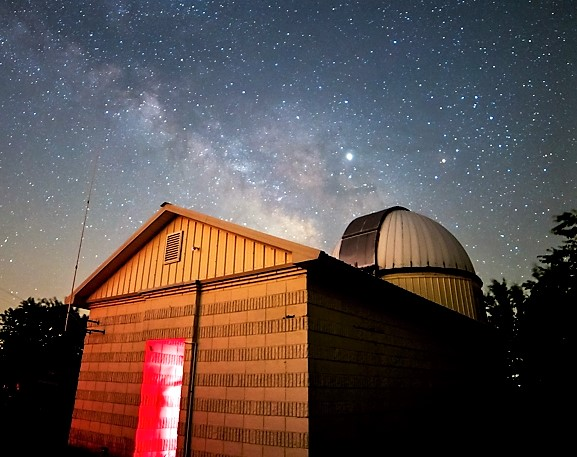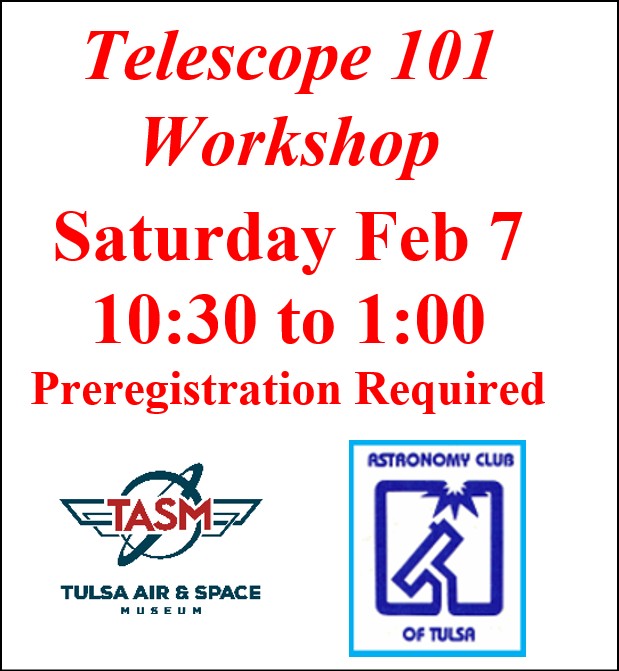Phases of the Moon
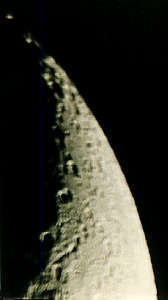
During the crescent phase
of the moon, you get great
views of the craters.
In this lesson, I am going to talk about the lunar phases that occur as the moon orbits the earth. I will cover general information about the phases, explain why we see the phase we do during the month, and how to tell time by looking at the phase of the moon.
First lets get into some general information about the moon's orbit around the earth. The moon takes almost 28 days to orbit the earth, 27.32 to be exact, and 1 lunar day lasts 27.32 earth days. As the moon rotates around the earth, it also rotates around its own axis at the same rate. This is why we always see the same side of the moon. The eccentricity of orbit is 0.055, which means there is a 5.5-degree tilt as the moon orbits the earth. If this tilt were not there, we would see an eclipse of the moon and sun every month. Since the moon can be below or above the earth’s orbital plane there is no eclipse. However, there are two points in the earth’s orbit around the sun where the full or new moon is in correct alignment to cause an eclipse. When this happens and the moon is full, we see a lunar eclipse. If the phase of the moon is new, we see a solar eclipse. The moon orbits the earth in a counter clockwise direction. Since this is the case, the moon moves from west to east across the sky. If you watch the moon move during one night, it looks like the moon goes from east to west. This is because of the earth’s rotation. If you watch the moon over a few nights, you can see the movement from west to east by looking at the background stars. Because of the direction the moon moves, it rises about 50 minutes later each day. As the moon moves each day, the phase of the moon changes.
The phases of the moon work in a cycle. It starts with the new moon. This occurs when the moon is between the earth and the sun. Remember, because of a 5.5-degree tilt, a solar eclipse may or may not occur. During this phase the sun and moon are close together in the sky. This is the reason we never see the moon when the phase is new and why astronomers look at stars during this time. As the moon orbits the earth, we start seeing the sunlit part of the moon forming the crescent phase of the moon (figure a, below). During this phase, we can see the daytime and the nighttime part of the moon allowing us to see the entire moon.
The reason we can see the dark side of the moon is because of earth shine. Earth shine (figure c, below) is the reflection of sunlight off the earth back to the moon. We see this part of the moon only during the crescent phase a few days after or before a new moon. As the moon begins to show more of a phase and gets brighter, the dark side of the moon becomes invisible.
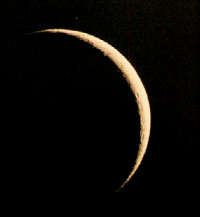
a)The moon at crescent phase
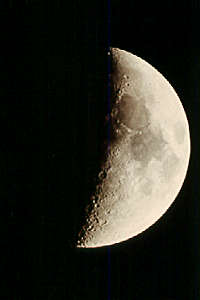
b)The moon now about 4 days old

c) Earthshine
On the seventh day of the moon's orbit, the phase becomes first quarter (figure d, below). Half of the moon is in daylight and the other in darkness. Because the moon is so bright, we can’t see the nighttime side. So why is this phase called first quarter instead of half phase? Simply put, the moon has completed one quarter of its orbit around the earth. The moon is 90 degrees from the sun at this point. You can tell when the moon is first quarter because the sunlit side is to the west, on the right side. A third quarter moon also shows half of the moon, but the sunlit side of the moon is on the left, facing east.
After the first quarter moon, we start seeing more of the sunlit part of the moon. Around day 10 of the moon's orbit, it becomes a gibbous phase and stays this way until we have a full moon.
The full moon (figure e, below) occurs on day 14 of the orbit around the earth. Now we can see the entire daytime side of the moon. When the sun, earth, and moon are in perfect alignment, we get a lunar eclipse. Since the moon orbits at a tilt, we don’t always get an eclipse every full moon. A full moon is 180 degrees from the sun. So the moon rises when the sun sets. When the moon rises, it looks much larger than when it is directly overhead. This is because the light is deflected though the earth’s atmosphere. When the moon is low, the light from the moon passes though more of the earth’s atmosphere than directly overhead. The moon is always the same size in the sky. You can prove this with a small telescope. Look at the moon when it is first rising with an eyepiece that fills the entire moon in your telescope. Then look at it again when the moon is high in the sky with the same telescope and eyepiece. You will see that the moon is the same size at anytime.
As the moon goes into day 17 of its orbit, it becomes a gibbous phase (figure f, below) again. This time however, the sunlit part of the moon is on the left side facing east. After full moon, the moon will rise later each night until it is a new phase again.
On day 21 of the moon's orbit, it rises around midnight local standard time. This is the third quarter phase of the moon. It's called third quarter because it has traveled three quarters of the way in its orbit around the earth. You know that the phase is third quarter when you see a half moon high in the sky at sunrise with the sunlit part of the moon to the left.
By day 25, the moon enters crescent phase again. The earth shine begins to show the nighttime side of the moon. Each day the crescent becomes thinner and thinner until the moon disappears on day 28 becoming a new moon once again.

d) First Quarter Moon
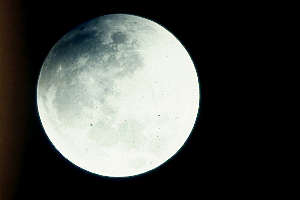
e) This is the full moon. This photograph
was taken just as a total eclipse of the moon
was just beginning
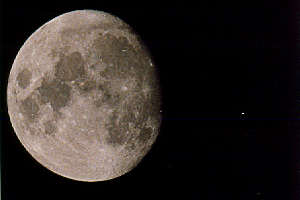
f) A gibbous moon just after full moon.
Notice the day lit side is now on the left side
Indications of Time
First Quarter Moon
It is 12 noon when the moon rises in the east. It is 3 p.m. when the moon is half way up the sky between the eastern horizon and the highest point the moon can get looking south. It is 6 p.m. when the moon is at its highest point in the sky looking south. It is 9 p.m. when the moon is half way up the sky between the western horizon and the highest point the moon can get looking south. It is midnight when the moon sets.
Full Moon
It is 6 p.m. when the moon rises in the east. It is 9 p.m. when the moon is half way up the sky between the eastern horizon and the highest point the moon can get looking south. It is midnight when the moon is at its highest point in the sky looking south. It is 3 a.m. when the moon is half way up the sky between the western horizon and the highest point the moon can get looking south. It is 6 a.m. when the moon sets.
Third Quarter Moon
It is midnight when the moon rises in the east. It is 6 a.m. when the moon is at its highest point in the sky looking south. It is 9 a.m. when the moon is half way up the sky between the western horizon and the highest point the moon can get looking south. It is 12 noon when the moon sets
The phases of the moon can also help you tell what time of day it is. In order for you to get a close guess on the time, you need to know roughly what time the sunrise or sunset is for that day. These are the facts you need to remember. The first quarter moon rises six hours after sunrise and sets six hours after sunset. The same is similar for the third quarter moon. It rises 6 hours before sunrise and sets 6 hours after sunrise. Finally the full moon rises when the sun sets and sets when the sun rises.
Timetable Chart
This example is assuming that sunrise is at 6:00 am and sunset is 6:00pm at a location of forty degrees north latitude.
| MEAN RADIUS: | 1737.4 km |
| MASS: | 0.012 (Earth=1) |
| DENSITY: | 3.34 (gm/cm) |
| GRAVITY: | 0.165 (Earth=1) |
| ORBIT PERIOD: | 27.32 (Earth days) |
| ROTATION PERIOD: | 27.32 (Earth days) |
| DISTANCE: | 384,400 km |
| ECCENTRICITY OF ORBIT: | 0.055 (5.5%) |


